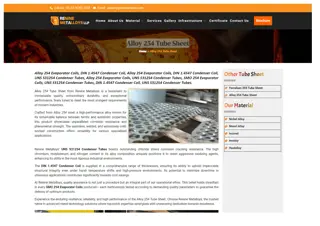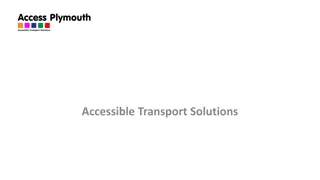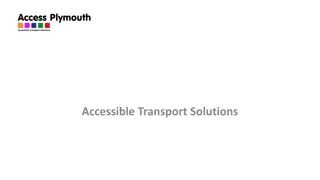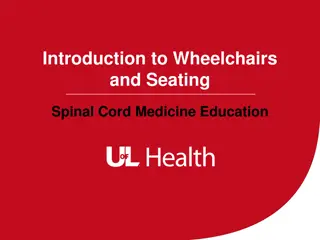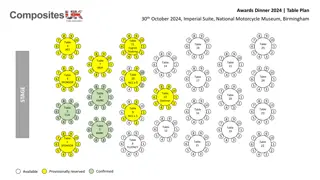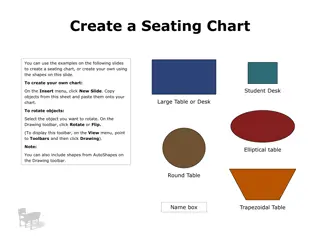
Wheelchair Seating Concepts and Prescribing Guidelines
Explore the fundamentals of wheelchair seating concepts and prescribing guidelines, including important measurements for selecting the right wheelchair based on individual needs and specific impairments. Discover the process of choosing the ideal wheelchair for a patient, considering factors such as patient-therapist collaboration, resource availability, and custom-welded wheelchair frames.
Download Presentation

Please find below an Image/Link to download the presentation.
The content on the website is provided AS IS for your information and personal use only. It may not be sold, licensed, or shared on other websites without obtaining consent from the author. If you encounter any issues during the download, it is possible that the publisher has removed the file from their server.
You are allowed to download the files provided on this website for personal or commercial use, subject to the condition that they are used lawfully. All files are the property of their respective owners.
The content on the website is provided AS IS for your information and personal use only. It may not be sold, licensed, or shared on other websites without obtaining consent from the author.
E N D
Presentation Transcript
Aids and Appliances: Wheelchairs and Seating Concepts Eric Johns, PT DPT Health Volunteers Overseas With slides by Felix Kaphwiyo
Prescribing a WC choice of words tone of voice empathy, patient guardian involvement time taken
Measuring a WC will do in lab Sketch[important because of terminology] Sit pt on bed side, knees approx 90degrees Leave 1 to 3cm/ 2 to 3 fingers between seat edge and knee fold or [Deduct 2" from the measured length for clearance. Block sides for accuracy, measure the distance between the blocks Add +/- 2cm for winter clothing Back rest any where between inferior angle of scapular and the superior angle If more trunk support is required, measure from the seat platform up to the required level of support. Height, from ground to fold of knee at 90* Arm rests. Flex elbows 90 degrees, measure form seat to the flexed arm
important Measure the way you do a WC Plus the length of an outstretched arm for the propulsion unit Always explain clearly your decision to prescribe Always ascertain that the client will use it. It costs more to make [age, social activities, environment]
Fundamentals of seating Think of wheelchairs as a prescription: just like a patient is prescribed the right medication out of many possibilities, based on their disease, the therapist should choose just the right wheelchair, out of many different types, for their patient, based on the patient s specific impairments This process is obviously impacted by the resources at hand. But I have also seen how the wheelchair frames at the Orthopedic centre are being custom-welded, which presents a wonderful opportunity to create the specific wheelchair best for a given patient
Fundamentals of seating How does your patient look when seated at the edge of bed/mat? Are you going to try to accommodate it, or correct it?
Pressure Mapping Red = greatest pressure, blue = least pressure What does this tell you about where a patient who can t move is likely to develop pressure injuries/wounds??? YOUR job as the therapist is to adapt the environment in order to: More evenly distribute pressure across tissues Develop a plan to frequently, completely offload areas of greatest pressure
Ultralight Wheelchair For a full time long term wheelchair user who can self-propel perhaps someone with a thoracic or lumbar complete spinal cord injury Drawback: expensive to buy and repair
Custom Wheelchair Components Contoured seat cushion Backrest with lateral support
Good trunk control: use low backrest for greater freedom of movement and to keep postural muscles strong
Little to no trunk or head control: contoured backrest with headrest, reclined to keep patient from falling forward Or a more affordable alternative
Power Wheelchairs Main benefit: independent mobility for someone who cannot walk, nor propel a wheelchair using arms Drawbacks: heavy (>100kg) and very expensive (more than a car) Newer models are better with uneven terrain
Repairs and Maintenance Similar to a bicycle, a wheelchair will need repairs and maintenance over time. The harder it is used (community > indoors), the sooner parts will wear out, break, etc. Bent axles Flat tires Overstretched, worn, or torn fabrics Loose bolts
An understanding of seating and posture is important for other equipment too
Commode/toilet seat: Imported Locally made Consider: is it the right height for your patient s legs? Does the patient have adequate trunk control to sit without back support?
In summary This just scratches the surface of wheelchairs that are in use Wheelchairs are made by numerous companies around the world, and are also customized or custom-made by individuals when the need arises This lecture was intended to familiarize you with basic types of wheelchairs, components of wheelchairs, and how the patient and the wheelchair interact, so that you can assess wheelchairs independently in the future and make appropriate recommendations to patients
Transfer Aids Transfer board: helpful for someone with little to no LE strength. Can be made from polished wood or plastic. Useful also for bridging gaps between sitting surfaces for a transfer (increases safety)
Transfer aids Using a draw sheet: Can be done with an ordinary sheet placed under a patient Patient stays mostly supine Best used to transfer between 2 laying surfaces; if done to transfer to/from a WC, make sure the wheelchair is reclined Drawbacks: takes 2 people, doesn t let the patient participate much
Transfer aids Hoyer lift: does most of the work of the transfer. Lets 1 person transfer a dependent patient. Drawbacks: expensive, heavy and difficult to transport Has become more popular in some facilities in recent years as a way of reducing the number of back injuries among staff who transfer dependent patients frequently
Questions? To see more wheelchairs and equipment and see costs (USD), check out https://www.spinlife.com/




